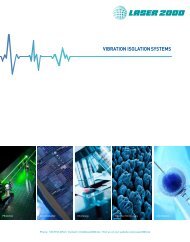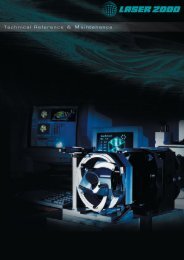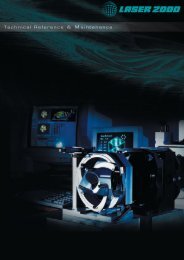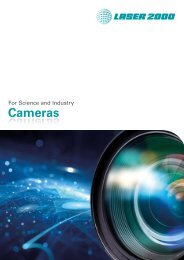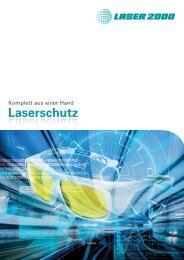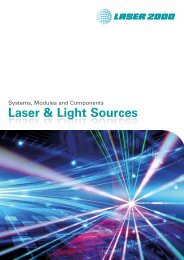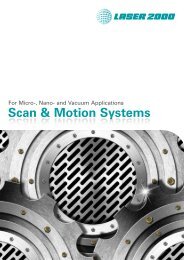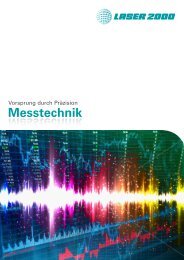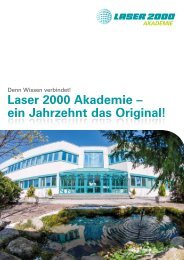Semrock Master Catalog 2018
Semrock Master Catalog 2018
Semrock Master Catalog 2018
You also want an ePaper? Increase the reach of your titles
YUMPU automatically turns print PDFs into web optimized ePapers that Google loves.
Polarizers<br />
<strong>Semrock</strong> White Paper Abstract Library<br />
Full downloadable versions are available on our website, www.semrock.com/white-papers.aspx<br />
Mirrors NIR Filters<br />
Edge<br />
Filters<br />
Dichroic<br />
Beamsplitters<br />
Laser-line<br />
Filters<br />
Laser Diode<br />
Filters<br />
Notch<br />
Filters<br />
Lamp Clean-up<br />
Filters<br />
Maximizing the Performance<br />
of Advanced Microscopes<br />
by Controlling Wavefront<br />
Error Using Optical Filters<br />
Wavefront distortion can degrade<br />
image quality by reducing contrast or<br />
compromising resolution. In several<br />
microscopy applications, reducing<br />
wavefront distortion is critical to<br />
achieving the microscopy method.<br />
Specifying and selecting optical filters<br />
that minimize wavefront aberration<br />
is important to maximize or enable<br />
optical system performance. This article<br />
elucidates how to select optical filters<br />
for high performance microscopy,<br />
and provides guidance on choosing<br />
<strong>Semrock</strong> catalog filters for wavefront<br />
distortion performance required<br />
for applications.<br />
Super-resolution Microscopy<br />
The latest incarnation of the modern<br />
fluorescence microscope has led to<br />
a paradigm shift. This wave is about<br />
breaking the diffraction limit first<br />
proposed in 1873 by Ernst Abbe and<br />
the implications of this development<br />
are profound. This new technology,<br />
called super-resolution microscopy,<br />
allows for the visualization of cellular<br />
samples with a resolution similar to<br />
that of an electron microscope, yet it<br />
retains the advantages of an optical<br />
fluorescence microscope.<br />
Optical Filters for Laserbased<br />
Fluorescence<br />
Microscopes<br />
Lasers are increasingly and<br />
advantageously replacing broadband<br />
light sources for many fluorescence<br />
imaging applications. However,<br />
fluorescence applications based on<br />
lasers impose new constraints on<br />
imaging systems and their components.<br />
For example, optical filters used<br />
confocal and Total Internal Reflection<br />
Fluorescence (TIRF) microscopes<br />
have specific requirements that are<br />
unique compared to those filters<br />
used in broadband light source<br />
based instruments.<br />
Filter Sets for Next<br />
Generation Microscopy<br />
LED-based light engines are gaining<br />
in popularity for fluorescence imaging.<br />
However, the full potential of LED light<br />
engines remains to be realized in most<br />
imaging configurations because they<br />
are still being used with conventional<br />
filter sets designed for mercury or<br />
xenon arc lamps. <strong>Semrock</strong>’s LED-based<br />
light engine filter sets are aligned to<br />
the unique spectral peaks of the most<br />
popular LED-based light engines on the<br />
market today.<br />
Fluorescent Proteins:<br />
Theory, Applications<br />
and Best Practices<br />
The latest incarnation of the modern<br />
fluorescence microscope has led to<br />
a paradigm shift. This wave is about<br />
breaking the diffraction limit first<br />
proposed in 1873 by Ernst Abbe and<br />
the implications of this development<br />
are profound. This new technology,<br />
called super-resolution microscopy,<br />
allows for the visualization of cellular<br />
samples with a resolution similar to<br />
that of an electron microscope, yet it<br />
retains the advantages of an optical<br />
fluorescence microscope.<br />
Spectral Modeling in<br />
Fluorescence Microscopy<br />
SearchLight is a free, online spectrum<br />
plotting and analysis tool that allows<br />
fluorescence microscope users and<br />
optical instrument designers to model<br />
and evaluate the spectral performance<br />
of fluorophores, filter sets, light<br />
sources, and detectors as components<br />
of an overall system. This white paper<br />
provides the theoretical basis for the<br />
SearchLight calculations, illustrating<br />
the individual aspects with academic<br />
precision, but also with very useful<br />
insights into practical problems related<br />
to noise in biological fluorescence<br />
microscopy systems.<br />
Spectral Imaging<br />
with VersaChrome<br />
Spectral imaging with linear unmixing<br />
is necessary in multicolor fluorescence<br />
imaging when fluorophore spectra<br />
are highly overlapping. Tunable<br />
fluorescence filters now enable spectral<br />
imaging with all the advantages of thinfilm<br />
filters, including high transmission<br />
with steep spectral edges and high outof-band<br />
blocking.<br />
Creating Your Own<br />
Bandpass Filter<br />
<strong>Semrock</strong>’s VersaChrome Edge filters<br />
unlock virtually unlimited spectral<br />
flexibility for fluorescence microscopy<br />
and hyperspectral imaging as well as<br />
spectroscopy applications. By utilizing<br />
a combination of VersaChrome Edge<br />
tunable long-wave-pass and shortwave-pass<br />
filters, a bandpass filter<br />
as narrow as sub 5nm FWHM or as<br />
wide as 12% of the center wavelength<br />
throughout the visible and near-infrared<br />
wavelength ranges can be created.<br />
<strong>Semrock</strong> VersaChrome<br />
Tunable Bandpass Filters<br />
Many optical systems can benefit from<br />
tunable filters with the spectral and<br />
two-dimensional imaging performance<br />
characteristics of thinfilm filters and the<br />
center wavelength tuning speed and<br />
flexibility of a diffraction grating.<br />
Flatness of Dichroic<br />
Beamsplitters Affects<br />
Focus & Image Quality<br />
Dichroic beamsplitters are now used<br />
as “image-splitting” elements for<br />
many applications, such as live-cell<br />
imaging and FRET, in which both the<br />
transmitted and reflected signals are<br />
imaged onto a camera. The optical<br />
quality of such dichroics is critical<br />
to achieving high-quality images,<br />
especially for the reflected light. If the<br />
beamsplitter is not sufficiently flat, then<br />
significant optical aberrations may be<br />
introduced and the imaging may be<br />
severely compromised.<br />
More<br />
110



